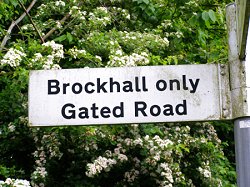It is probable that badgers were present in this area as far back as 250,000 years ago, as fossil remains of the species dating from around that time have been in found in nearby Cambridgeshire. Over the following millenia, changes in climate and advancing and retreating ice sheets have pushed badgers (and people) out of the area and allowed them back again several times.

Road sign for Brockhall
Jumping forward to within one thousand years of the present day we find what is almost certainly the first written evidence of badgers in West Northamptonshire. The Domesday Book of 1086 includes a record for the settlement of Brocole, a name which is generally accepted to mean ‘badger hole’. In later records the village is referred to as Brockhole, but from around the fifteenth century it has been known as Brockhall. The first recorder of badger setts in Northamptonshire, A.W. Leftwich, wrote: “Badgers have been known and protected on this estate for centuries. Hence the name Brockhall.”
Moving even closer to the present day, there is an article about badgers in the Journal of the Northamptonshire Natural History Society, dated 1901, in which Edward Leach wrote that “In our own locality they are plentiful”.
Mr Leach’s statement, made just over a century ago, remains true today. Badgers are widespread across the South-Western half of Northamptonshire. They are most numerous in the hillier areas where there is sandy soil into which they can dig their setts and where there is plenty of earthworm-rich pasture in which to forage. On the lower-lying plains, where the fields are mainly arable and the underlying geology is mostly heavy clay, badgers are less common.
Most of our badgers’ setts are excavated in wooded, sloping ground or hedgebanks. Setts in open fields are not unusual though. Some badgers have tunnelled into man-made slopes such as road, rail or canal embankments and cuttings. And while most of our badgers live in the countryside, there are also a number of active setts within Northampton. One lies within a mile (1.6 km) of the town centre.
In the past our badgers were regularly persecuted, with ‘badger digging clubs’ operating in the south of the county and possibly elsewhere up to the 1950s or the early 1960s. Although badgers have been protected by law since 1973 (and their setts have also been protected since 1991), illegal persecution still occurs. Thankfully the number of incidents appears to be low.
The biggest threats to ‘Brock’ in the Brockwatch area today are road traffic (which is thought to kill 200-300 of our badgers every year) and urban development. Although legal protection for badgers and their setts means that developments do not harm badgers directly, the loss of foraging areas can lead to their eventual disappearance. With major expansion plans for Northampton, Daventry and Towcester, and with traffic volumes on our roads continually increasing, many badgers in Northampton and South-West Northants face an uncertain future.

